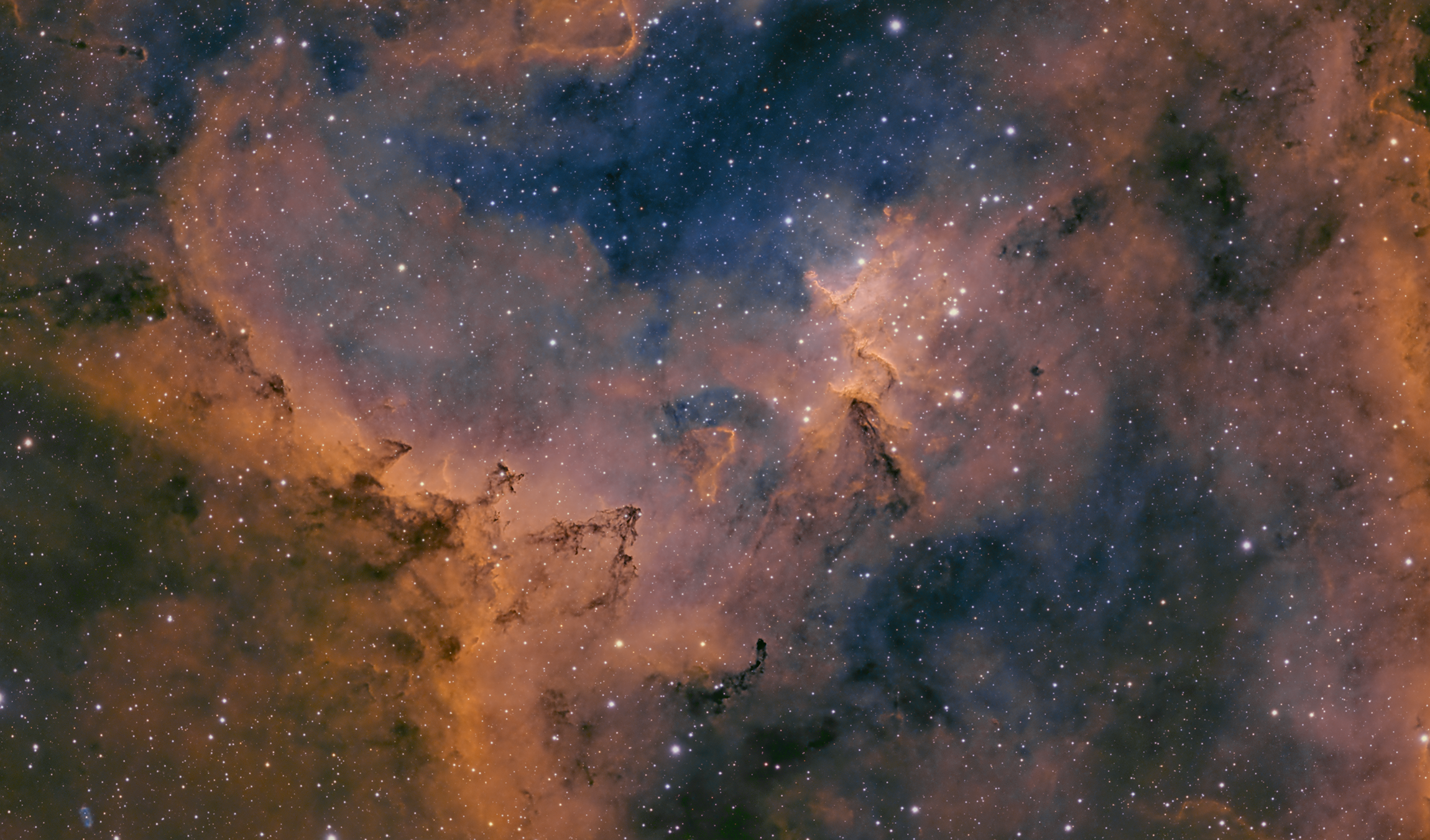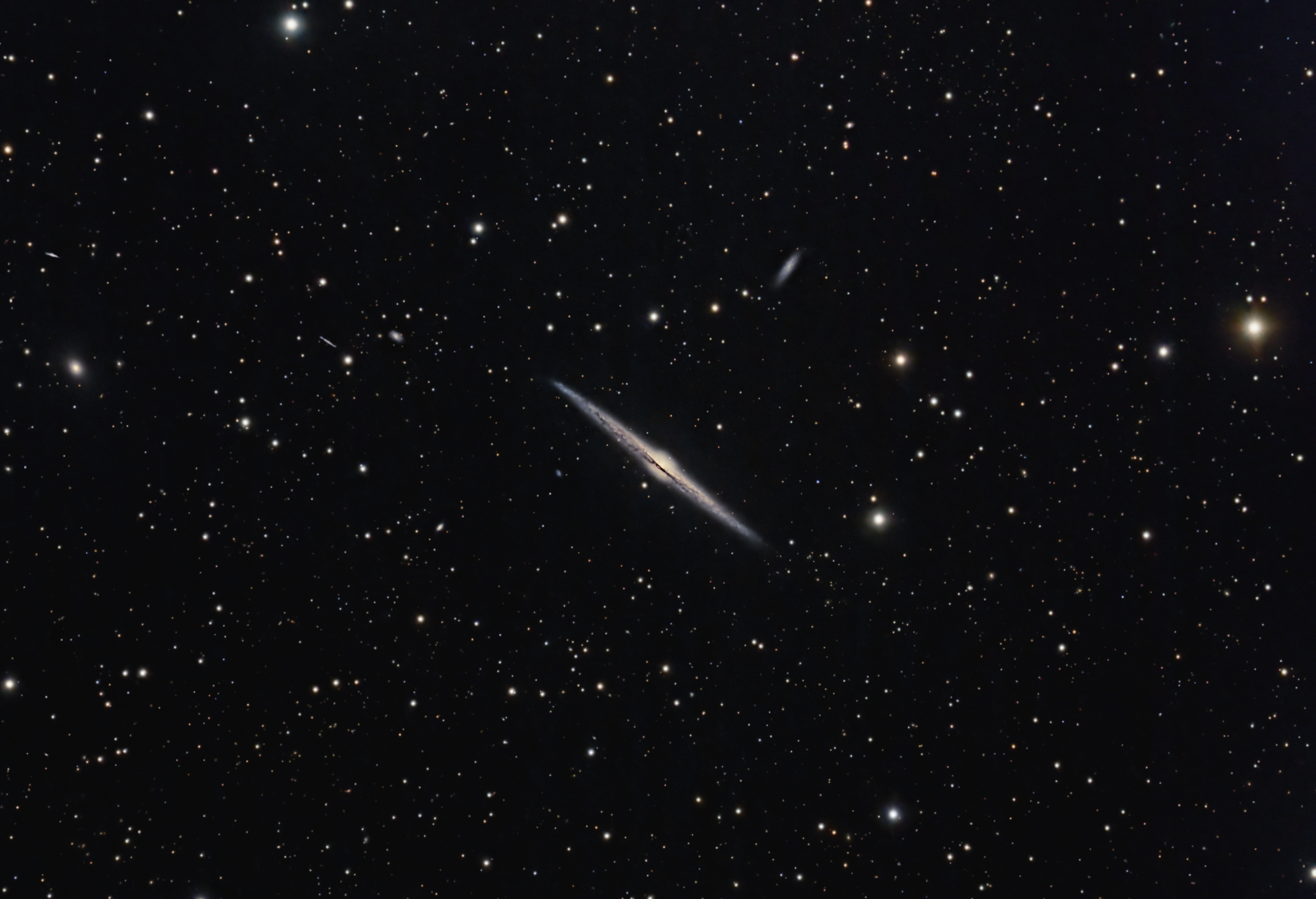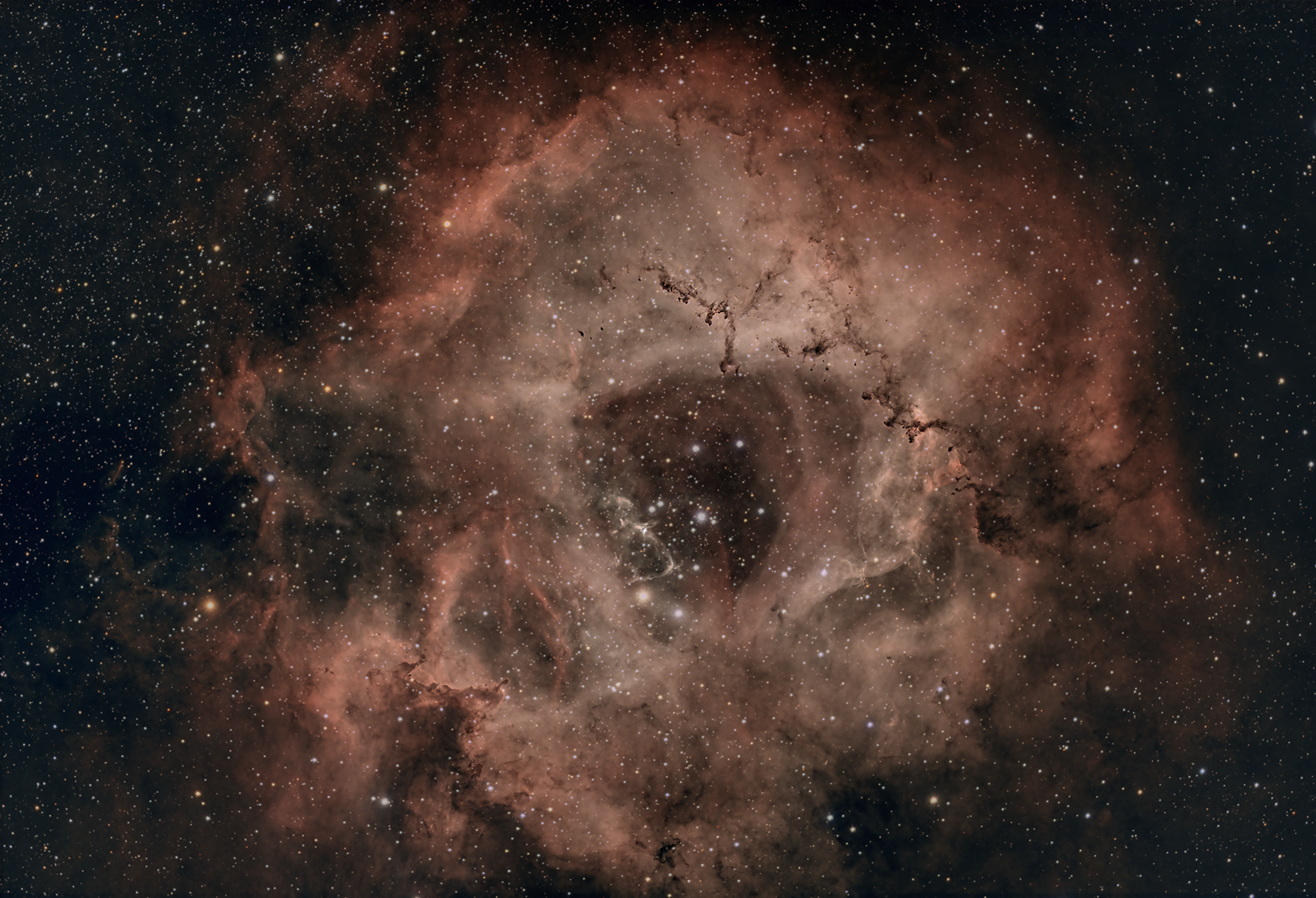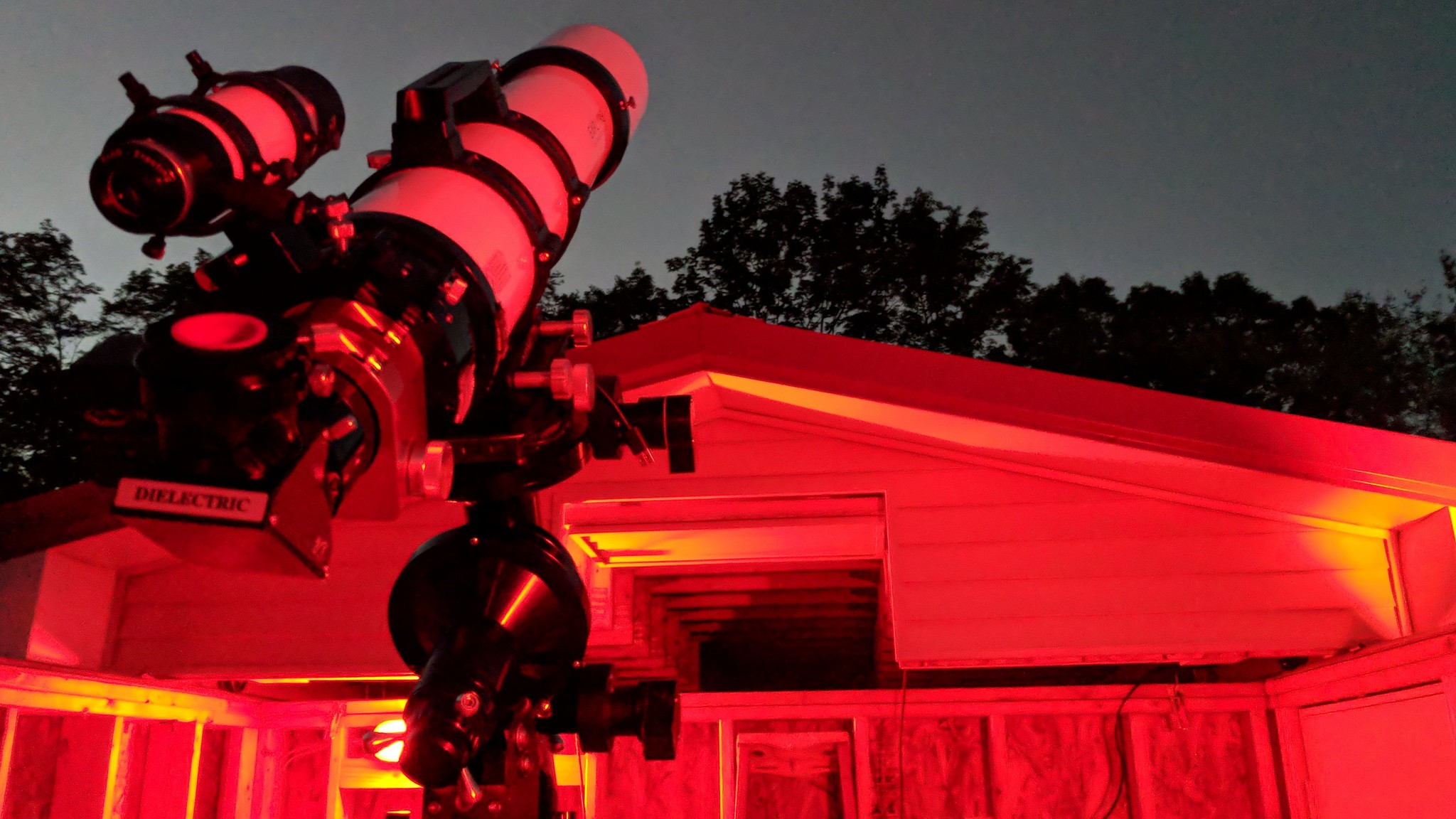Melotte 15 and the innards of the Heart nebula are often overlooked with the beauty of the Heart Nebula itself.. Fun to zoom in a bit and crop out some of the awe. This is what astronomical observation is about.
If you would like to see Full Resolution Images, Please check one of the following:
- Astrobin submission for capture details: https://www.astrobin.com/2y0f2q/
- Flickr for full resolution: https://flic.kr/p/2ocAnwT
The very first image I took back in November of 2018, from my newly ‘operational’ observatory, was The Heart Nebula. It was a fairly moony night, and I honestly spent about ⅔ of the night swearing at my gear for not working right, yelling at a crazy fox who was most definitely saying “why are you here?” I was extremely frustrated at my lack of knowledge and experience in astrophotography gear essentials. I had a boss once who always used to say, “Do you feel that feeling of discomfort there? Yes! That is actually called growth!” Truth is I felt a lot of growth this particular night. And this is the result of that first fiasco. It is only 20 frames at 2 minutes exposure with an Ha filter applied.

I really wanted to revisit the Heart Nebula with my current gear, but unfortunately, I’m unable to get a clean framing of The Heart Nebula due to a variety of factors. However, that was no reason to skip it all together, as it is filled with a great number of amazing targets. At the heart of the heart is a bunch of wild nebulosity with the most prominent looking feature known as Melotte 15. A complex twist of gas and dust seen in a merged RGB, SHO and HSO false color image. This image is a cropped field, and it was fun to merge an RGB, HSO and SHO frames together for a lovely effect. The RGB was really very little data at 30 minutes each channel to capture star color.

Here is an annotated version of the image showing many of the dark nebula indicators:

Here is the image without the distraction of the stars. Although including the stars also makes a compelling image, removing them really does let you focus in on the complex nature of the gases and dust that make up the nebula.

Gear Used:
- Stellarvue SVX102T
- Losmandy G11 Mount
- ZWO ASI2600MMP
Image Capture Details:
False Color Palette: RGB HSO & SHO Merge
Notes: RGB Frames primarily for starfield. Admittedly I need to get more OIII and S2 frames in the mix to help improve depth and color correctness. Sadly end of night weather conditions on tw2o nights hazed up those frames.
- Red – 6 x 300s
- Green – 6 x 300s
- Blue – 6 x 300s
- H-Alpha – 50 x 300s
- S2 – 38x 300s
- OIII – 38 x 300s
Lessons Learned:
I really wanted to image the Heart Nebula during this series of captures. If I had the right hardware to attach my Stellarvue Focal Reducer I would have the full Heart Nebula field of view. I went to attach the focal reducer, and I didn’t have the right size connectors or hardware, and so I missed the opportunity. I wasted about an hour of imaging time with fumbling around with this. This comes back to planning and verification before the actual imaging session. Getting the right connection hardware is just something that needs to be done ahead of time. Never waste valuable dark sky time on gear when it can be avoided. Work it out during the daytime or cloudy nights. Funny how that was two imaging sessions of the Heart Nebula with Amateur gear management. The very first session in 2018 described above, and this one.
This is the first image where I have used the RC Astro BlurXterminator and NoiseXterminator Processes in PixInsight. Likewise, it is the first time I have used the DarkStructureEnhance enhance script. I ‘m still getting a feel for these VERY powerful tools, and hope I didn’t overdo it. As Ron Brecher always reminds us, “People really over-cook them.” It is hard to find reference images here with the newness of these tools. Their power will change the sharpness baseline over time. While I find my way through this, I do remember that when I over-cook a porterhouse steak on my Traeger grill, it is still wonderful and juicy.
Image Processing Workflow:
- AstroPixel Processor – Calibration & Integration
- Light and Calibration Frames Definition
- Calibration of Light Frames – Mostly Default Settings
- Star and Frame Quality Analysis
- Frame Registration
- Frame Normalization
- Image Integration
- Channel Combination
- RGB Combine: RGBHSO2, SHO (Hubble)
- PixInsight – Post Processing
- Dynamic Crop
- Dynamic Background Extraction (DBE)
- Background Neutralization
- BlurXterminator
- Histogram Transformation
- SCNR – Green Removal
- NoiseXterminator
- DarkStructureEnhance Script
- StarExterminator – Create a star frame and a non-stellar frame
- Removed stars from both RGBHSO2 and SHO frames
- Kept the color extract, but didn’t bring over the SHO extract.
- Save frames as 16 bit TIF
- Photoshop – Post Processing
- Load starless frame as background
- blend in SHO data frame
- Load Star frame and set up Blending to be Linear Dodge Add
- Starless Processing:
- Levels and Curves
- Hue, Vibrance and Saturation
- Topaz Labs – Adjust AI – very mild sharpening and clarity. Final tweaks on Black settings, highlights and clarity. Mild Detail enhancements. Just enough to make some of the edges pop without hitting the “tuftiness” of the gas clouds.
- Final Color Tweaks – specific features using masks.
- For some reason, despite running SCNR before, there was a very strong green hue in the dark regions. I used Photoshop “Color Replace” to get rid of that.
- Stars Processing:
- Modify Star Brightness and fuzz up a bit
- Star saturation boost
- Publishing of 1x, .5x and .25x PNG files
From ChatGPT:
The Heart Nebula, also known as IC 1805, is a large emission nebula located in the constellation Cassiopeia. It is a part of a much larger complex of nebulae known as the Cassiopeia-Cepheus Molecular Cloud. Within the Heart Nebula, there are several dark nebulae, which are clouds of dust and gas that block the light from the stars behind them. These dark nebulae, also known as “absorption nebulae”, give the Heart Nebula its characteristic shape, which is said to resemble a human heart. The dark nebulae are thought to be caused by the presence of dense pockets of dust within the larger nebula. They play an important role in the formation of new stars, as they provide the material needed for the formation of new stellar systems. The Heart Nebula is located about 7500 light-years away from Earth and can be observed with a telescope or a long-exposure photograph.
Melotte 15 is an open cluster of stars located in the constellation Cassiopeia. It is considered one of the densest and most compact clusters in the Milky Way galaxy. It is estimated to be around 1.5 million years old. The cluster contains several bright, hot blue stars, as well as red giants and red supergiants. It is also home to a large number of brown dwarfs and low-mass stars.
One of the most notable features of Melotte 15 is the high concentration of massive stars within the cluster. It is estimated to contain around 100 massive stars, with some of the most massive stars having a mass of over 100 solar masses. These massive stars are responsible for the intense ultraviolet radiation and strong stellar winds that shape the surrounding interstellar medium.
Melotte 15 is located about 7,100 light-years from Earth, in the Perseus Arm of the Milky Way galaxy. It is one of the closest known open clusters to Earth, and is visible to the naked eye under good observing conditions. It can be observed with a small telescope or binoculars and its proximity and high concentration of massive stars make it an ideal target for the study of massive star formation and evolution.
Melotte 15 is also known as h Persei, and is a popular object for the amateur astronomers. It can be found by following an imaginary line from the star Caph (β Cassiopeiae) through Ruchbah (δ Cassiopeiae) and on to Melotte 15.
As Melotte 15 is a relatively close open cluster and has a high concentration of massive stars, it is an attractive target for astronomical research. There have been several studies on the cluster in recent years, focusing on various aspects such as its stellar population, star formation, and interstellar medium.
One recent study, published in 2019, used multi-wavelength observations to study the massive stars in the cluster. The study found that the massive stars in Melotte 15 have a wide range of ages, with some stars as young as 1 million years old and others up to 4 million years old. This suggests that star formation has been ongoing in the cluster for a prolonged period of time.
Another study, published in 2020, used observations from the Chandra X-ray Observatory to study the X-ray emission from the massive stars in the cluster. The study found that the massive stars in Melotte 15 are strong X-ray emitters, and that the X-ray emission is associated with the strong stellar winds from these stars. This provides insight into the processes that shape the interstellar medium in the cluster.
A study that was published in 2020, used data from the European Space Agency’s Gaia satellite to study the dynamics and kinematics of stars in the Melotte 15. The study found that Melotte 15 is a dynamically evolved cluster, with the majority of its stars located close to the center of the cluster, and an outer halo of stars that have been likely ejected due to the dynamical interactions.
In summary, Melotte 15 is a subject of ongoing research, with studies focusing on its stellar population, star formation, and interstellar medium. These studies are providing new insights into the processes that shape open clusters and the massive stars that reside in them.




